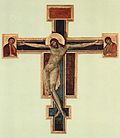Wikipedia:Today's featured article/April 14, 2017
The Crucifix by Cimabue at Santa Croce is a large wooden crucifix painted c. 1265, one of two attributed to the Florentine painter and mosaicist Cimabue. Painted in distemper, it was commissioned by the Franciscan friars of Santa Croce and is built from a complex arrangement of timber boards. Displaying technical innovations and humanistic iconography, it is one of the first Italian artworks to break from the late medieval Byzantine style. The gilding and monumentality of the cross link it to the Byzantine tradition. Christ's static pose is reflective of this style, while the work overall incorporates newer, more naturalistic aspects. It presents a lifelike and physically imposing depiction of the passion at Calvary. Christ is shown nearly naked: his eyes are closed, his face lifeless and defeated. His body slumps in a position contorted by prolonged agony and pain. The painting is a graphic and unflinching portrayal of human suffering, and has influenced painters from Michelangelo to Francis Bacon. It has been in the Basilica di Santa Croce since the late 13th century, and at the museum at Santa Croce since restoration following flooding of the Arno in 1966. (Full article...)

